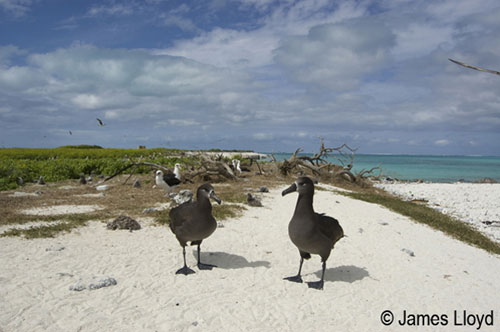The U.S. Fish & Wildlife Service (USFWS) has announced the reopening of a request for information from the public on a petition to list the Black-footed Albatross Phoebastria nigripes as a threatened or endangered species under the Endangered Species Act.
In October 2004, the USFWS received a petition requesting the Black-footed Albatross be listed as a threatened or endangered species and that critical habitat be designated concurrently with the listing. In October 2007 the USFWS published a finding that the petition presented substantial scientific or commercial information indicating that listing the Black-footed Albatross may be warranted. The agency then began a status review of the species.

The reopening of this request for additional information and comment does not change the petition finding, but allows additional time for interested parties to provide valuable input that will be an important source of information for the status review and decision on whether to propose listing the Black-footed Albatross for ESA protection. During the review, a species may be determined to be endangered or threatened due to one or more of the following five factors:
- the present or threatened destruction, modification, or curtailment of its habitat or range;
- overutilization for commercial, recreational, scientific, or educational purposes;
- disease or predation;
- the inadequacy of existing regulatory mechanisms; and
- other natural and manmade factors affecting its continued existence.
Threats to the Black-footed Albatross are incidental mortality from longline fishing and from mercury and organochlorine contaminants such as PCBs and DDTs. These substances, used in industry and agriculture, pose a toxicological risk and interfere with reproduction. Rising sea levels and the loss of low-lying oceanic islands due to climate change is another threat.
The total breeding population of the Black-footed Albatross numbers roughly 61 000 pairs, with 97% of the population breeding in the predator-free Northwestern Hawaiian Islands, now included within Papahānaumokuākea Marine National Monument. The majority of those are found on Midway Atoll and Laysan Island. The remaining 3% of the birds nest on several remote Japanese islands. Exploitation of the species for eggs and feathers in the 19th and early 20th centuries eliminated breeding colonies on four islands or atolls and in two island groups across the Pacific.
The USFWS is soliciting data and other information regarding the species to ensure a comprehensive review. To be considered in the 12-month finding for this petition, data, information, and comments must be submitted to the USFWS by 25 September 2009. Comments may be sent via the Internet [click here].
Copies of the Federal Register notice may be downloaded from the USFWS's website.
Lindsay Young, North Pacific News Correspondent, 28 August 2009

 English
English  Français
Français  Español
Español